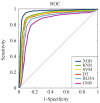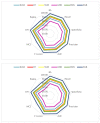Predictive Model for Mortality in Severe COVID-19 Patients across the Six Pandemic Waves
- PMID: 38005862
- PMCID: PMC10675561
- DOI: 10.3390/v15112184
Predictive Model for Mortality in Severe COVID-19 Patients across the Six Pandemic Waves
Abstract
The impact of SARS-CoV-2 infection remains substantial on a global scale, despite widespread vaccination efforts, early therapeutic interventions, and an enhanced understanding of the disease's underlying mechanisms. At the same time, a significant number of patients continue to develop severe COVID-19, necessitating admission to intensive care units (ICUs). This study aimed to provide evidence concerning the most influential predictors of mortality among critically ill patients with severe COVID-19, employing machine learning (ML) techniques. To accomplish this, we conducted a retrospective multicenter investigation involving 684 patients with severe COVID-19, spanning from 1 June 2020 to 31 March 2023, wherein we scrutinized sociodemographic, clinical, and analytical data. These data were extracted from electronic health records. Out of the six supervised ML methods scrutinized, the extreme gradient boosting (XGB) method exhibited the highest balanced accuracy at 96.61%. The variables that exerted the greatest influence on mortality prediction encompassed ferritin, fibrinogen, D-dimer, platelet count, C-reactive protein (CRP), prothrombin time (PT), invasive mechanical ventilation (IMV), PaFi (PaO2/FiO2), lactate dehydrogenase (LDH), lymphocyte levels, activated partial thromboplastin time (aPTT), body mass index (BMI), creatinine, and age. These findings underscore XGB as a robust candidate for accurately classifying patients with COVID-19.
Keywords: COVID-19; SARS-CoV-2; XGB; coagulation disorder; cytokine release syndrome; machine learning.
Conflict of interest statement
The authors declare no conflict of interest. The funders had no role in the design of the study; in the collection, analyses, or interpretation of data; in the writing of the manuscript; or in the decision to publish the results.
Figures






Similar articles
-
Predictive role of clinical features in patients with coronavirus disease 2019 for severe disease.Zhong Nan Da Xue Xue Bao Yi Xue Ban. 2020 May 28;45(5):536-541. doi: 10.11817/j.issn.1672-7347.2020.200384. Zhong Nan Da Xue Xue Bao Yi Xue Ban. 2020. PMID: 32879103 Chinese, English.
-
Application of Machine Learning in Hospitalized Patients with Severe COVID-19 Treated with Tocilizumab.J Clin Med. 2022 Aug 12;11(16):4729. doi: 10.3390/jcm11164729. J Clin Med. 2022. PMID: 36012968 Free PMC article.
-
Multi-centre, three arm, randomized controlled trial on the use of methylprednisolone and unfractionated heparin in critically ill ventilated patients with pneumonia from SARS-CoV-2 infection: A structured summary of a study protocol for a randomised controlled trial.Trials. 2020 Aug 17;21(1):724. doi: 10.1186/s13063-020-04645-z. Trials. 2020. PMID: 32807241 Free PMC article.
-
Artificial intelligence in clinical care amidst COVID-19 pandemic: A systematic review.Comput Struct Biotechnol J. 2021;19:2833-2850. doi: 10.1016/j.csbj.2021.05.010. Epub 2021 May 7. Comput Struct Biotechnol J. 2021. PMID: 34025952 Free PMC article. Review.
-
Obesity in patients with COVID-19: a systematic review and meta-analysis.Metabolism. 2020 Dec;113:154378. doi: 10.1016/j.metabol.2020.154378. Epub 2020 Sep 28. Metabolism. 2020. PMID: 33002478 Free PMC article.
Cited by
-
Systemic Lupus Erythematosus: How Machine Learning Can Help Distinguish between Infections and Flares.Bioengineering (Basel). 2024 Jan 17;11(1):0. doi: 10.3390/bioengineering11010090. Bioengineering (Basel). 2024. PMID: 38247967 Free PMC article.
-
The Relationship between the Laboratory Biomarkers of SARS-CoV-2 Patients with Type 2 Diabetes at Discharge and the Severity of the Viral Pathology.J Pers Med. 2024 Jun 17;14(6):646. doi: 10.3390/jpm14060646. J Pers Med. 2024. PMID: 38929867 Free PMC article.
-
Personalized Assessment of Mortality Risk and Hospital Stay Duration in Hospitalized Patients with COVID-19 Treated with Remdesivir: A Machine Learning Approach.J Clin Med. 2024 Mar 22;13(7):1837. doi: 10.3390/jcm13071837. J Clin Med. 2024. PMID: 38610602 Free PMC article.
-
Development of Predictive Models Based on Biochemical Parameters to Triage COVID-19 Patients: A Study Conducted in a Tertiary Care Hospital.Cureus. 2024 Mar 14;16(3):e56197. doi: 10.7759/cureus.56197. eCollection 2024 Mar. Cureus. 2024. PMID: 38618472 Free PMC article.
-
External validation of the sICOP score for early mortality in mechanically ventilated patients with COVID-19.Acute Med Surg. 2024 Dec 9;11(1):e978. doi: 10.1002/ams2.978. eCollection 2024 Jan-Dec. Acute Med Surg. 2024. PMID: 39659555 Free PMC article.
References
-
- Chen N., Zhou M., Dong X., Qu J., Gong F., Han Y., Qiu Y., Wang J., Liu Y., Wei Y., et al. Epidemiological and clinical characteristics of 99 cases of 2019 novel coronavirus pneumonia in Wuhan, China: A descriptive study. Lancet. 2020;395:507–513. doi: 10.1016/S0140-6736(20)30211-7. - DOI - PMC - PubMed
Publication types
MeSH terms
LinkOut - more resources
Full Text Sources
Medical
Research Materials
Miscellaneous

